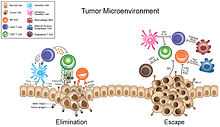Immunoediting
Immunoediting is a dynamic process that consists of immunosurveillance and tumor progression. It is made up of three phases: elimination, equilibrium, and escape.[1]
Definition
Immunoediting is characterized by changes in the immunogenicity of tumors due to the anti-tumor response of the immune system, resulting in the emergence of immune-resistant variants.[2]
Phase 1: Elimination

The elimination phase, also known as immunosurveillance, includes innate and adaptive immune responses to tumour cells. For the innate immune response, several effector cells such as natural killer cells and T cells are activated by the inflammatory cytokines, which are released by the growing tumour cells, macrophages and stromal cells surrounding the tumour cells. The recruited NK cells macrophages produce interleukin 12 and interferon gamma, which kill tumour cells by cytotoxic mechanisms such as perforin, TNF-related apoptosis-inducing ligands (TRAILs), and reactive oxygen species.[3]
Phase 2: Equilibrium
The next step in cancer immunoediting is the equilibrium phase, during which tumor cells that have escaped the elimination phase and have a non-immmunogenic phenotype are selected for growth. It is the longest of the three processes in cancer immunoediting and may occur over a period of many years. During this period of Darwinian selection, new tumor cell variants emerge with various mutations that further increase overall resistance to immune attack.[3]
Phase 3: Escape
During the escape phase, tumor cell variants selected in the equilibrium phase have breached the host organism's immune defenses, with various genetic and epigenetic changes conferring further resistance to immune detection.[1]
See also
References
- ↑ 1.0 1.1 Dunn, Gavin P.; Old, Lloyd J.; Schreiber, Robert D. (2004). "The Three Es of Cancer Immunoediting". Annual Review of Immunology 22 (1): 329–360. doi:10.1146/annurev.immunol.22.012703.104803. PMID 15032581.
- ↑ "Immunoediting". Springer Science+Business Media. Retrieved 26 June 2014.
- ↑ 3.0 3.1 Kim, Ryungsa; Emi, Manabu; Tanabe, Kazuaki. "Cancer immunoediting from immune surveillance to immune escape". Immunology 121 (1): 1–14. doi:10.1111/j.1365-2567.2007.02587.x. PMC 2265921. PMID 17386080.